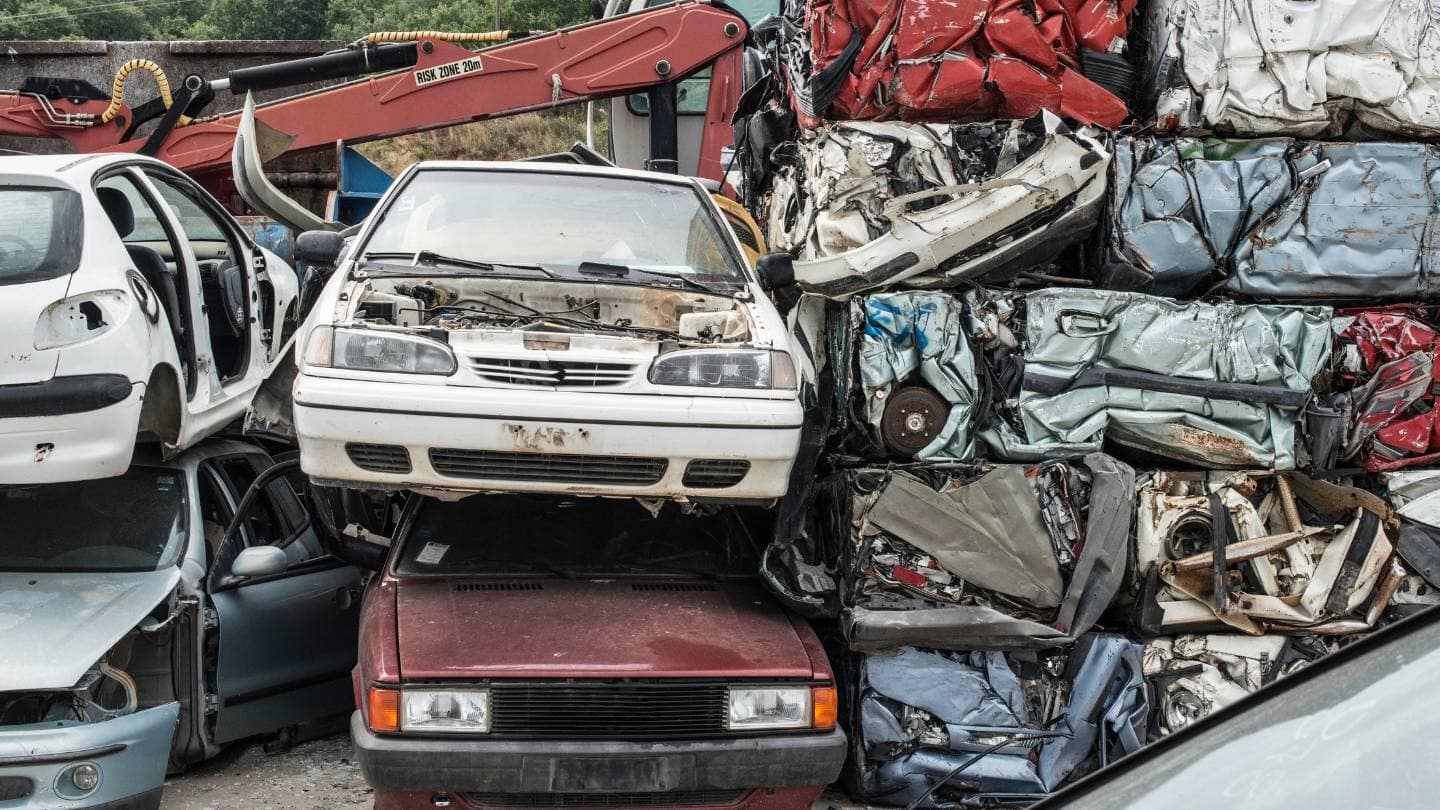Have you ever wondered what happens to cars after they reach the end of their lifespan? Car recycling is crucial in reducing waste and conserving valuable resources.
This blog post will break down the car recycling process into simple, easy-to-understand steps. You’ll learn what happens to your vehicle once it’s sent to be recycled and how this process benefits both the environment and the economy.
Let’s Get Straight to the Point
The car recycling process involves several steps: preparing your car by removing personal items, draining hazardous fluids, and salvaging valuable parts. The vehicle is then shredded, and metals are separated for reuse.
Recycling cars reduces landfill waste, conserves resources like steel and aluminium, and lowers carbon emissions. For electric vehicles (EVs), the battery is carefully removed and recycled.
The process benefits the environment by saving energy, protecting natural resources, reducing pollution, and creating jobs in the recycling and manufacturing sectors.
What Is Car Recycling?
Car recycling involves dismantling vehicles for spare parts and reusing materials.
It’s an eco-friendly way of dealing with no longer roadworthy cars, allowing for the recovery of valuable materials such as steel, aluminium, and plastic.
In Australia, about 95% of a car’s materials can be recycled, which is essential in reducing landfill waste.
1. Why Is Car Recycling Important?
- Reduces Waste: Recycling cars minimises the amount of waste in landfills.
- Conserves Resources: Materials like steel, aluminium, and plastic are reclaimed and reused, reducing the need for new resources.
- Environmental Benefits: Recycling reduces harmful emissions from manufacturing and saves energy.
The Car Recycling Process
So, how does the car recycling process work? Here’s a step-by-step breakdown.
Step 1: Preparing Your Car for Recycling
Before your vehicle can be recycled, a few important steps must be taken.
1. Find the Vehicle’s Title or Registration
Before handing over your vehicle for recycling, you need to prove ownership. Ensure you have your vehicle’s title or registration documents on hand. Without these, the recycling centre may not process your car legally.
2. Remove Personal Items
It’s easy to forget personal belongings in the car, especially in the glovebox, boot, or under the seats. Remove any personal items before the car is handed over for recycling.
3. Cancel Your Insurance
Don’t forget to cancel your car insurance. This ensures you’re not paying for a vehicle you no longer own.
Step 2: Draining and Removing Hazardous Materials
Once your car arrives at the recycling facility, removing hazardous fluids and materials is the first step.
1. Drain Engine Fluids
All engine fluids, including oil, coolant, and brake fluid, must be drained to prevent environmental contamination. These fluids are either safely disposed of or recycled.
2. Remove the Battery
The car battery is carefully removed. Batteries, especially lead-acid batteries, contain harmful chemicals that must be handled carefully. In some cases, the battery can be refurbished and reused.
Step 3: Removing Valuable Parts
Before the car is crushed or shredded, valuable parts are removed for resale or reuse.
1. Tyres, Rubber, and Plastic Components
Components such as tyres, rubber hoses, and plastic reservoirs are removed for reuse or recycling. Tyres can be repurposed for other uses, like playground surfaces or asphalt.
2. Resellable Parts
Parts like the engine, transmission, and alternator can often be refurbished and resold. Some components are valuable second-hand, especially for older or rare car models.
Step 4: Shredding the Car Frame
Once all usable parts and hazardous materials have been removed, the car’s body is sent for shredding.
1. Separating Metals
During shredding, a powerful magnet separates ferrous metals (metals containing iron, like steel) from non-ferrous metals (like aluminium and copper).
These metals are then sent to manufacturers to be melted down and reused in new products, including new cars.
Step 5: The Environmental Benefits of Car Recycling
Recycling a car provides numerous environmental benefits. Here are just a few:
1. Reduces Carbon Emissions
Recycling metals and other materials reduces the need for mining and manufacturing new resources. This saves energy and significantly lowers carbon emissions, creating a cleaner environment.
2. Conserves Natural Resources
Materials like steel, aluminium, and plastic are finite. Recycling old cars reduces the need for mining and extracting these resources from the earth. This helps protect ecosystems and reduces the strain on natural resources.
3. Reduces Landfill Waste
Cars left to rot in landfills can leak harmful chemicals into the ground, contaminating soil and water. Car recycling helps keep these hazardous materials out of landfills, ensuring they are disposed of or reused responsibly.
How Are Electric Vehicles (EVs) Recycled?
Recycling electric vehicles (EVs) presents challenges due to their different construction, particularly the battery pack.
1. Battery Removal and Recycling
The lithium-ion batteries in EVs contain valuable materials like cobalt, nickel, and lithium.
These batteries are removed and refurbished for reuse or dismantled in a sealed environment to prevent hazardous leaks. The recovered metals are then purified for reuse in new batteries or other applications.
2. Shredding and Reusing the Car Frame
Just like traditional cars, the metal frame of an electric vehicle is shredded and separated. However, EV frames often contain lighter materials like aluminium, which require specialised recycling processes.
These metals are then sent to manufacturers for reuse in new EVs or other products.
The Benefits of Recycling Old Cars
Recycling old cars offers multiple benefits for the environment and society.
1. Job Creation
The car recycling industry provides jobs in various sectors, including dismantling, sorting, transporting, and manufacturing.
Additionally, businesses that refurbish and resell parts contribute to the local economy.
2. Energy Savings
Recycling metals like aluminium and steel uses significantly less energy than producing new metals. For example, recycling aluminium saves up to 95% of the energy required to create it from raw materials.
This energy saving translates into lower emissions and a smaller environmental footprint.
3. Supports Sustainable Practices
By participating in car recycling, you’re contributing to a more sustainable future. Reducing waste, conserving resources, and lowering emissions are all steps towards a greener planet.
Conclusion
Car recycling is essential for reducing waste, protecting the environment, and conserving valuable resources.
By ensuring that old vehicles are dismantled, hazardous materials are handled responsibly, and metals are reclaimed, we reduce our reliance on raw materials and contribute to a circular economy.
So, the next time you’re ready to part with your old car, remember that recycling is the best way to give it a second life and help protect the environment for future generations.
Frequently Asked Questions about Car Recycling
1. What happens to my car when it’s recycled?
The car recycling process involves removing personal items, draining hazardous fluids, salvaging valuable parts, shredding the car frame, and reusing metals.
2. Why is car recycling important for the environment?
Car recycling reduces landfill waste, conserves resources like steel and aluminium, lowers carbon emissions, and prevents harmful chemicals from polluting the soil and water.
3. How are electric vehicles (EVs) recycled?
EV recycling involves carefully removing and refurbishing lithium-ion batteries and shredding and recycling the car’s frame. The recovered metals are reused in new products, including batteries and vehicles.
4. What parts of my car can be resold or reused?
Valuable components like tyres, batteries, engines, transmissions, and other resellable parts are removed before shredding. These can often be refurbished and sold for reuse.
5. How does recycling cars benefit the economy?
Car recycling creates jobs in dismantling, refurbishing, and manufacturing, reduces energy consumption in metal production, and supports sustainable practices, helping the local and global economy.



